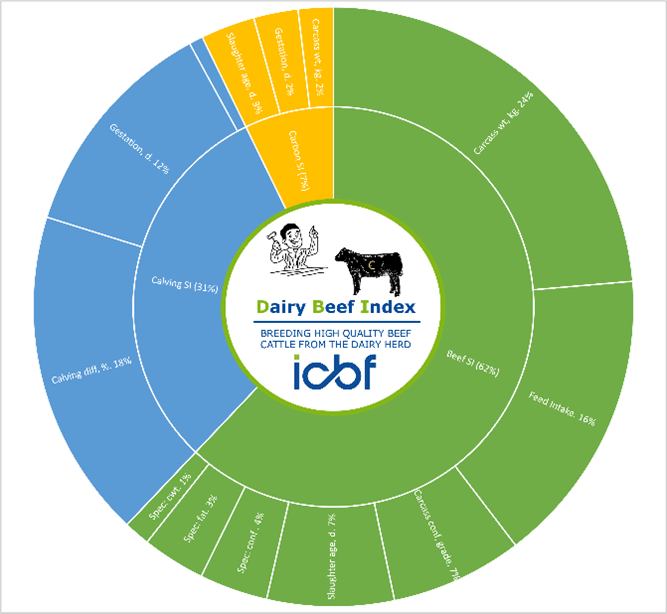The most recent evaluation published by ICBF on 24th January 2023 saw a suite of updates incorporated into the Dairy Beef Index (DBI).
These changes are a continuation of updates that were made to the EBI in November 2022. Changes to the DBI broadly include the addition of a NEW Carbon Sub-Index and the Beef Sub-Index has been developed further. The updated relative emphasis can be seen in Figure 1.

As a result of these changes, most animals have increased by ~€30 DBI. This can be attributed mostly to the changes in the Beef Sub-Index. The correlation in DBI between the Jan’23 evaluation and the previous evaluations (Nov’22) is very high at 0.96. This means that while farmers will observe an increase in overall DBI value, there are few animals re-ranked as a result of the changes introduced.
What are the changes?
Updates to the Beef Sub-Index
- Updated economic values
Economic Values were updated to reflect the price paid for cattle in recent years. This has resulted in higher economic values being applied to carcass traits in the DBI.
- New Trait: Age at Slaughter
Until now, beef breeding focused on carcass weight, conformation and fat score. Thus, the goal was to breed heavier muscled animals, which receive a high-value carcass at slaughter. However, the cost of each additional day to slaughter was not considered. Due to new research in Teagasc, the DBI now includes an age at slaughter trait which identifies sires that will have progeny ready for slaughter at a younger age. Age at slaughter is included in the updated DBI at cost of €1.35/day, which represents the average cost of keeping animal across the year, at a relative emphasis of 7%.
- New Trait: ‘In-Spec’
A new composite ‘in-spec’ trait was introduced with the aim of identifying progeny that conform to desired factory specifications for carcass weight (280 to 380 kg), conformation (O= and better), and fat (2+ to 4=). Cattle that do not meet desired specifications are penalised in the factory and the DBI now reflects those penalties.
Inclusion of a Carbon Sub-Index
Carbon emissions from the dairy and beef herd is a major concern. Although carbon is not a direct economic cost for farmers today, it is likely farmers will be charged for carbon in the future so the inclusion of a carbon component in the DBI will breed an animal with a lower carbon footprint. The Agri Sector has been set a target of reducing emissions by 25% (5.75 Mt CO2e) by 2030. Genetics has been tasked with reducing this figure by 1.2Mt of CO2e and the inclusion of a new Carbon Sub-Index into the DBI is imperative to achieving this target.
Carbon is being included by assessing the impact that each trait has on ‘carbon’ production. The carbon value is assessed as the change in total emissions per unit change in the trait of interest holding all other traits constant. Traits that increase feed intake – increase emissions and hence, are penalised in the Carbon SI. Traits that reduce feed intake or change diet reduce emissions and hence, are rewarded in the Carbon SI. Total carbon value is converted to an economic value by a price per tonne of carbon; this has been set at €80/tonne.
Traits included in the DBI Carbon Sub Index:
- Gestation
- Carcass weight
- Age at Slaughter
Animals that have a genetically short gestation length , produce lighter carcasses and those that finish earlier in life benefit the most from these changes.
For more information on the DBI see Understanding the Dairy Beef Index.
